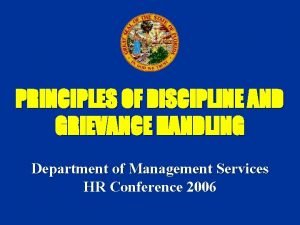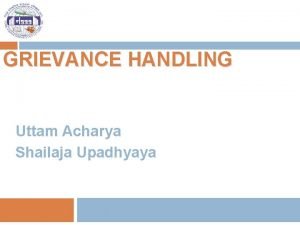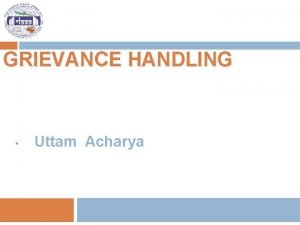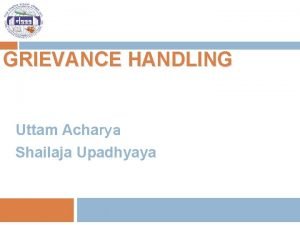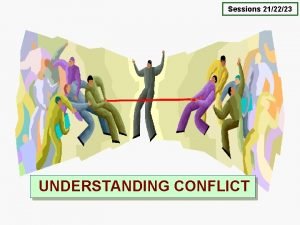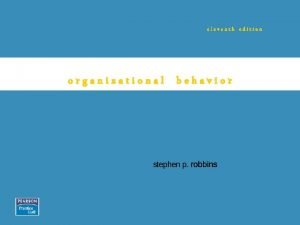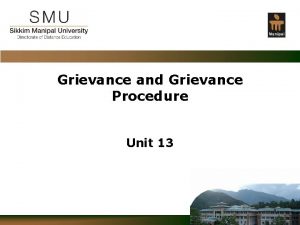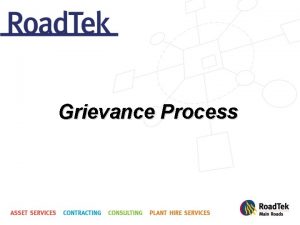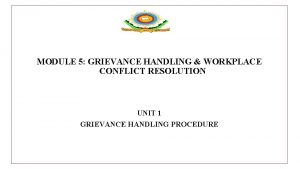MODULE 5 GRIEVANCE HANDLING CONFLICT RESOLUTION UNIT 2












- Slides: 12

MODULE 5: GRIEVANCE HANDLING & CONFLICT RESOLUTION UNIT 2 WORKPLACE CONFLICT RESOLUTION

Introduction Ø It was acknowledged in previous discussions that grievance can lead to conflict. Ø With the emergence of conflict, there are provisions to resolve same. Ø These mechanisms are from both internal (voluntary) to external (compulsory) Ø By definition; Workplace conflict resolution refers to resolving dispute to the approval of one or both parties.

Mechanisms of Workplace Conflict Resolution 1. Deputation 2. Joint consultation 3. Bargaining 4. Mediation 5. Board of inquiry 6. Conciliation 7. Arbitration 8. Industrial court

Deputation Ø This is a management deceptive move towards employees by involving them in resolving conflict but subsequently neglecting their contribution and sticking to their own opinion. ØIt has been referred to as autocratic style of management and common in nonunionised organisations.

Joint Consultation Ø This is a means by which matters of substance that do not fall within the ambit of bargaining can be discussed in a cooperative atmosphere. ØIt implies the means whereby management and employees may come together and where appropriately determine matters affecting their joint or respective interests. ØThis involves a mutual effort of the employees and employers towards resolving issues of mutual interests. Common issues are; welfare, safety, productivity, canteen, among others.

Individual Bargaining Ø This is a round table discussion of the conflictive parties. Ø Through negotiated agreement, conflict can be resolved. Ø Individual bargaining is between an employer and worker. Ø Although to some extent such effort can be regarded as personal relationship, which is defined by the contract between the parties. ØThe rules, which determine the nature and extent of this relationship, are common law rules, which apply the principle of non-interference. ØThis is obtainable at the entry point of worker or in a non-unionised work setting where the employer and employee freely define the terms and conditions of their relationship.

Collective Bargaining Ø This is a process whereby the terms and conditions of employment and variation of such terms and conditions are peacefully agreed upon through negotiation between the employer and the workers union. Ø It is “the process of arriving or attempting to arrive at a collective agreement”. Ø It is the process of working out a modus vivendi between two partiesemployer and trade union organisation in matters regarding the terms and conditions of employment, that is the right and interests of both parties.

Mediation Ø This has been described as the first style of the compulsory resolution of conflict. Ø The trade Disputes Act requires parties to submit their dispute to a mutually agreed mediator, if the internal machinery fails. Ø Only few private sector employers use mediation especially in resolving interpersonal, procedural and implementation of disputes. ØUnder mediation, the neutral third-party facilitator gathers information, frames issues, develops options, negotiates and formalizes agreement. ØParties in mediation create their own solutions and the mediator does not have any decisionmaking power over the outcome.

Board of Inquiry Ø This is fact finding machinery which traces the history of the particular dispute, the immediate and remote cause(s), the issues and positions of the parties, and what factors influence the parties’ positions. ØThe board is not necessarily set up to proceed conciliation but can proffer solutions, for instance, by aiding negotiation but if it does not, in principle, serves as a settlement machinery. Ø It is most useful if the issue involves the public – customer, host community, etc.

Conciliation Ø The law empowers the Ministry of Employment, Labour and Productivity (MELP) to appoint a fit person to act as a conciliator for the purpose of effecting a settlement of the dispute. Ø A conciliator is a person who is knowledgeable in industrial relations, mostly from the MELP and not below the rank of senior labour officer. Ø Failure of mediation, within seven days appoints a conciliator to look into the matter and the duties of the conciliator are to inquire into the causes and circumstances of disputes and to negotiate with the partner to resolve the dispute. ØThe conciliator as the chairman must not criticize a party at a joint meeting or in the presence of the other party. Ø Again, he/she is not expected to do or say anything that will strengthen the position of the party on a particular issue. Ø Where a settlement is reached within fourteen (14) days of his appointment, report is sent to the Minister in charge of MELP. Ø The memorandum must be signed by representatives of the partners involved and becomes binding on them. Ø If could not be settled within 14, the conciliator will send a report to the Minister for appropriate action which is reference to arbitration

Industrial Arbitration Panel Ø This is a tripartite agency comprising of a chairman, his deputy, and 12 other members, four of whom are nominated equally by employers and labour. Ø Within 7 days of the receipt of a report from the conciliator, the Minister in charge of MELP must refer unresolved disputes to IAP, which has 21 days, unless an extension is granted, to give its award. ØThe minister is required to publish the IAP award within a maximum of 21 days within which either party to the dispute may raise objection. If no notice of objection is given to the Minister in charge of MELP within the stipulated time, such award will be published in the government Gazettee a notice confirming the award and the award shall be binding on the parties involved. ØHowever, in the face of objection, the Minister in question shall then refer the dispute to National Industrial Court (NIC) for the final determination.

Industrial Court Ø This is otherwise referred to as National Industrial Court (NIC) composed of a president and four (4) other members who are referred to as judges. It has exclusive jurisdiction to; Ø- make awards in the settlement of trade disputes and Ø- determine the interpretation of its own award, a collective agreement award of the IAP or the terms of settlement of any trade dispute. ØThe National Industrial Court (NIC) has original jurisdiction on disputes, which emanate in an essential service and those referred to it directly by the Minister-in-charge of MELP. To a large extent, the NIC enjoys much more independence than the IAP, which explains the relative confidence.
 What is conflict and conflict resolution?
What is conflict and conflict resolution? Principles of grievance handling
Principles of grievance handling Objectives of grievance handling
Objectives of grievance handling Objectives of grievance handling
Objectives of grievance handling Objectives of grievance handling
Objectives of grievance handling Pondy's model of conflict
Pondy's model of conflict High resolution low resolution
High resolution low resolution What is conflict of interest
What is conflict of interest Mythical fixed pie
Mythical fixed pie Dimensions of conflict handling intentions
Dimensions of conflict handling intentions Cudsa communication model meaning
Cudsa communication model meaning Introduction of work immersion
Introduction of work immersion Find the number of rectangles?
Find the number of rectangles?

